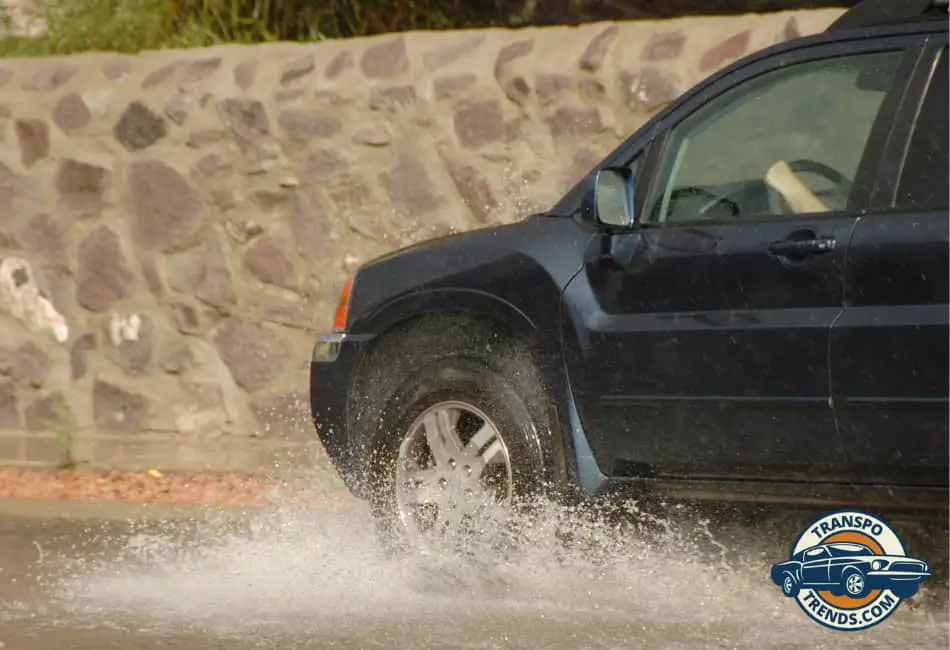Driving through water can sometimes result in unexpected issues — one common problem being the illumination of the dreaded check engine light.
This can be a source of anxiety for many drivers, as it often signifies a potential issue that requires immediate attention.
Understanding the Check Engine Light
The check engine light serves as a crucial alert system within your vehicle. Its primary function is to indicate potential issues within your car’s engine or related systems.
Think of it as your car’s way of communicating, signaling that something needs your attention.
The light is connected to your vehicle’s onboard diagnostics system. When the system detects a problem that could potentially affect your car’s performance or emissions, it triggers the check engine light.
This could range from minor issues like a loose gas cap to serious problems like a malfunctioning catalytic converter. Ignoring the check engine light could lead to more severe problems down the line.
By dismissing the light, you may miss the opportunity to address an issue while it’s still minor, potentially leading to costly repairs or even irreversible engine damage.
Therefore, it’s paramount to promptly address the check engine light to maintain your vehicle’s health and ensure its longevity.
Why Does the Check Engine Light Come On After Driving Through Water?
Water has the potential to activate the check engine light due to various factors. Let’s explore the primary ones:
1. Impacting Sensors
Water can affect sensitive components such as your vehicle’s sensors, especially when splashed in certain areas.
For instance, your car’s oxygen sensor, which is responsible for regulating the fuel-air mixture, can deliver incorrect data if exposed to water. This confusion can cause the check engine light to illuminate.
2. Affecting Connectors
Connectors in your car are designed to transmit electrical signals between various parts. Splashing water can interfere with this transmission, leading to erratic signals that can cause the check engine light to come on.
3. Disturbing the Exhaust System
The exhaust system, specifically the catalytic converter, plays a critical role in controlling emissions. If water enters the exhaust pipe and reaches the converter, it could cause it to malfunction, triggering the check engine light.
4. Temporary Sensor Glitch
Sometimes, exposure to moisture can cause a temporary glitch in your sensor readings. This could be due to either physical moisture interfering with the sensor or electrical issues caused by the water. While this might resolve once the car dries out, it can still cause the check engine light to turn on.
5. Damaging the Spark Plugs
Water getting into the engine can affect the spark plugs responsible for igniting the fuel-air mixture in the engine cylinders. Wet spark plugs can cause misfires, leading to the illumination of the check engine light.
6. Compromising the Air Intake System
Most vehicles’ air intake systems are located close to ground level. If water is ingested through the air intake into the engine, it can cause a condition known as hydrolock, leading to severe engine damage and triggering the check engine light.
7. Interfering with Fuel Cap
Water can also interfere with the sealing of the fuel cap. A loose or ill-fitting fuel cap can lead to fuel vapor leakages, disrupting your car’s fuel system and causing the check engine light to come on.
Diagnosing the Issue
Safety should always be your first consideration when diagnosing the issue causing your check engine light to come on.
Before you start inspecting your vehicle, ensure it is parked on a level surface, the engine is turned off, and the car has cooled down to avoid injuries.
Now, let’s delve into the common diagnostic steps:
- Use an OBD-II Scanner
On-Board Diagnostics II (OBD-II) scanners are universal tools that can read error codes from virtually any vehicle manufactured from 1996 onwards.
Connect an OBD-II scanner to the OBD-II port in your vehicle, usually located under the dashboard.
Once connected, the scanner will retrieve any stored error codes that have triggered the check engine light.
- Interpreting Error Codes
The OBD-II scanner will display alphanumeric codes corresponding to specific issues. For example, codes beginning with P0 are standard codes recognized by all car manufacturers, while codes starting with P1 are manufacturer-specific.
The subsequent digits can denote various issues, from a misfiring engine to a malfunctioning sensor.
For precise interpretation of these codes, refer to your vehicle’s manual or consult a trusted automotive resource online.
- Consult a Professional
If the error codes are complex or you’re unable to decipher them, it’s wise to consult a professional mechanic.
They are equipped with advanced diagnostic tools and have the expertise to identify and swiftly resolve the issue accurately.
Remember, the illumination of the check engine light shouldn’t be dismissed lightly. It’s a warning that something could be seriously wrong with your vehicle. Ignoring it could lead to major damage, expensive repairs, or even a breakdown.
DIY Solutions and Precautions
Before jumping to any conclusions and rushing to a mechanic, it’s crucial that you carry out some simple checks and maintenance tasks yourself. Safety is paramount, so always follow your vehicle’s owner’s manual and safety guidelines.
Inspecting Air Intake Components for Water Intrusion
Begin by checking the air intake components. Look for signs of water intrusion, which may cause the check engine light to illuminate.
Water can damage the mass airflow sensor, leading to incorrect readings. If water intrusion is detected, take the necessary steps to drain it and prevent future occurrences.
Drying Out Electrical Connections and Sensors
Next, inspect electrical connections and sensors. If any moisture is present, it could interfere with the signal transmission.
Dry out these components using a clean, absorbent cloth or a compressed air canister if available. Ensure all connections are secure and free of corrosion.
Verifying the Condition of the Catalytic Converter
Lastly, inspect the catalytic converter. It may trigger the check engine light if it is clogged, damaged, or not functioning properly.
A damaged catalytic converter will usually result in decreased performance and fuel efficiency and may produce a sulfur-like smell. If you suspect any issues, seek professional help right away.
Remember, these checks are meant to be the first steps in the diagnostic process. If the check engine light remains on after these steps, it’s time to consult a professional mechanic.
They have the expertise and tools to diagnose and fix the issue accurately. Ignoring the warning could lead to further damage, costly repairs, or even a vehicle breakdown. Always prioritize your vehicle’s health to ensure a smooth and safe driving experience.
Is an Engine Ruined if it Gets Water in it?
Water in an engine can certainly cause significant damage, but it doesn’t necessarily mean the engine is entirely ruined.
This phenomenon, often referred to as hydrolock, occurs when water enters the engine’s combustion chamber.
The severity of the damage to the engine depends on the amount of water ingested and the speed at which the engine is running at that moment.
If the engine is running at high RPMs, the damage can be catastrophic as water—being incompressible—doesn’t allow the pistons to complete their cycle, leading to a mechanical failure. This could result in bent connecting rods, broken pistons, or even damaged cylinder walls.
In the best-case scenario where the engine is not running or is running at a low speed, water can still cause problems such as diluted engine oil, corrosion, or fouled spark plugs.
Diluted oil reduces the effectiveness of lubrication, potentially leading to increased engine wear over time.
However, with immediate attention, engines that have ingested a small amount of water can often be saved.
It would involve removing the spark plugs, allowing the water to evaporate or drain, changing the oil, and replacing damaged components.
It is essential to address this issue promptly to minimize further damage and potential repair costs. Always consult a qualified mechanic if you suspect water ingestion in your vehicle’s engine.
FAQs
Q: Why does my check engine light come on after heavy rain?
A: Heavy rain can cause your check engine light to come on for several reasons. Water can find its way into your vehicle’s systems and components, affecting their functionality. For instance, if water gets into your vehicle’s fuel system, it could lead to a misfire in the engine, prompting the check engine light.
Q: How can I prevent water ingestion in my vehicle’s engine during heavy rainfall?
A: Prevention is always the best defense against water ingestion. Avoid driving through standing water if possible. If you must drive through a flooded area, do it slowly to prevent splashing. Regular maintenance and inspections of your vehicle’s critical systems can also help identify potential paths for water ingress and address them before they become a problem.
Q: What are the signs that my vehicle’s engine has ingested water during heavy rainfall?
A: Indications of water ingestion in your vehicle’s engine may include unusual noises, such as sputtering or popping sounds, reduced engine performance, or stalling. In severe cases, your vehicle might not start at all. If you’re experiencing any of these symptoms after driving in heavy rain or through water, seeking professional help immediately is crucial to prevent further engine damage.
Q: How does water ingestion in the engine impact my vehicle’s overall performance?
A: Water ingestion can severely impact your vehicle’s performance. Initially, you may notice reduced engine power, jerky acceleration, or unusual noises. If left unchecked, water can lead to significant engine damage, including bent rods, damaged pistons, or even a cracked engine block. These issues can lead to expensive repairs and prolonged downtime for your vehicle. Therefore, if you suspect that your engine has ingested water, it’s essential to seek professional help immediately.
Q: What steps should I take if I suspect my vehicle’s engine has ingested water?
A: If you suspect your engine has ingested water, it’s crucial not to start or continue running the vehicle as this could cause further damage. Instead, contact a professional mechanic or your insurance company immediately for advice. They may suggest towing the car to a garage for an inspection and necessary repairs. Always remember, prompt action is key to minimizing potential damage and costs.
Q: Can I prevent water ingestion in my vehicle’s engine during heavy rainfall?
A: Yes, there are preventative measures you can take to minimize the risk of water ingestion in your engine during heavy rainfall. Avoid driving through deep puddles or flooded roads, as this increases the likelihood of water entering your engine. If you must drive in such conditions, proceed slowly and keep your vehicle’s engine revs high. Regular servicing and inspections can also help identify potential vulnerabilities in your engine that might make it more susceptible to water damage.

